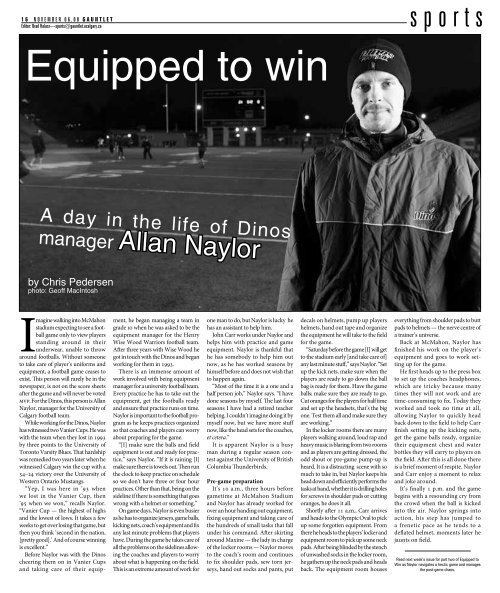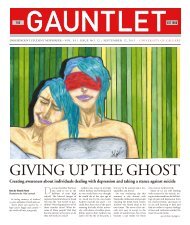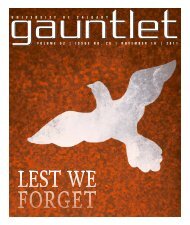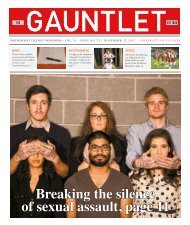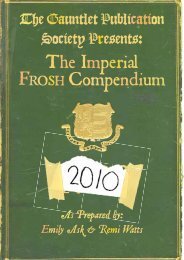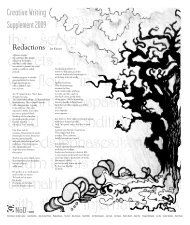Create successful ePaper yourself
Turn your PDF publications into a flip-book with our unique Google optimized e-Paper software.
16 NOVEMBER 06.08 GAUNTLET<br />
Editor: Brad Halasz—sports@gauntlet.ucalgary.ca<br />
sports<br />
Equipped to win<br />
A day in the life of Dinos<br />
manager Allan Naylor<br />
Allan Naylor<br />
by Chris Pedersen<br />
photo: Geoff MacIntosh<br />
Imagine walking into McMahon<br />
stadium expecting to see a football<br />
game only to view players<br />
standing around in their<br />
underwear, unable to throw<br />
around footballs. Without someone<br />
to take care of player’s uniforms and<br />
equipment, a football game ceases to<br />
exist. This person will rarely be in the<br />
newspaper, is not on the score sheets<br />
after the game and will never be voted<br />
MVP. For the Dinos, this person is Allan<br />
Naylor, manager for the University of<br />
Calgary football team.<br />
While working for the Dinos, Naylor<br />
has witnessed two Vanier Cups. He was<br />
with the team when they lost in 1993<br />
by three points to the University of<br />
Toronto Varsity Blues. That hardship<br />
was remedied two years later when he<br />
witnessed Calgary win the cup with a<br />
54–24 victory over the University of<br />
Western Ontario Mustangs.<br />
“Yep, I was here in ’93 when<br />
we lost in the Vanier Cup, then<br />
’95 when we won,” recalls Naylor.<br />
“Vanier Cup — the highest of highs<br />
and the lowest of lows. It takes a few<br />
weeks to get over losing that game, but<br />
then you think ‘second in the nation,<br />
[pretty good].’ And of course winning<br />
is excellent.”<br />
Before Naylor was with the Dinos<br />
cheering them on in Vanier Cups<br />
and taking care of their equip-<br />
ment, he began managing a team in<br />
grade 10 when he was asked to be the<br />
equipment manager for the Henry<br />
Wise Wood Warriors football team.<br />
After three years with Wise Wood he<br />
got in touch with the Dinos and began<br />
working for them in 1993.<br />
<strong>The</strong>re is an immense amount of<br />
work involved with being equipment<br />
manager for a university football team.<br />
Every practice he has to take out the<br />
equipment, get the footballs ready<br />
and ensure that practice runs on time.<br />
Naylor is important to the football program<br />
as he keeps practices organized<br />
so that coaches and players can worry<br />
about preparing for the game.<br />
“[I] make sure the balls and field<br />
equipment is out and ready for practice,”<br />
says Naylor. “If it is raining [I]<br />
make sure there is towels out. <strong>The</strong>n run<br />
the clock to keep practice on schedule<br />
so we don’t have three or four hour<br />
practices. Other than that, being on the<br />
sideline if there is something that goes<br />
wrong with a helmet or something.”<br />
On game days, Naylor is even busier<br />
as he has to organize jerseys, game balls,<br />
kicking nets, coach’s equipment and fix<br />
any last minute problems that players<br />
have. During the game he takes care of<br />
all the problems on the sidelines allowing<br />
the coaches and players to worry<br />
about what is happening on the field.<br />
This is an extreme amount of work for<br />
one man to do, but Naylor is lucky he<br />
has an assistant to help him.<br />
John Carr works under Naylor and<br />
helps him with practice and game<br />
equipment. Naylor is thankful that<br />
he has somebody to help him out<br />
now, as he has worked seasons by<br />
himself before and does not wish that<br />
to happen again.<br />
“Most of the time it is a one and a<br />
half person job,” Naylor says. “I have<br />
done seasons by myself. <strong>The</strong> last four<br />
seasons I have had a retired teacher<br />
helping. I couldn’t imagine doing it by<br />
myself now, but we have more stuff<br />
now, like the head sets for the coaches,<br />
et cetera.”<br />
It is apparent Naylor is a busy<br />
man during a regular season contest<br />
against the University of British<br />
Columbia Thunderbirds.<br />
Pre-game preparation<br />
It’s 10 a.m., three hours before<br />
gametime at McMahon Stadium<br />
and Naylor has already worked for<br />
over an hour handing out equipment,<br />
fixing equipment and taking care of<br />
the hundreds of small tasks that fall<br />
under his command. After skirting<br />
around Maxine — the lady in charge<br />
of the locker rooms — Naylor moves<br />
to the coach’s room and continues<br />
to fix shoulder pads, sew torn jerseys,<br />
hand out socks and pants, put<br />
decals on helmets, pump up players<br />
helmets, hand out tape and organize<br />
the equipment he will take to the field<br />
for the game.<br />
“Saturday before the game [I] will get<br />
to the stadium early [and take care of]<br />
any last minute stuff,” says Naylor. “Set<br />
up the kick nets, make sure when the<br />
players are ready to go down the ball<br />
bag is ready for them. Have the game<br />
balls; make sure they are ready to go.<br />
Cut oranges for the players for half time<br />
and set up the headsets, that’s the big<br />
one. Test them all and make sure they<br />
are working.”<br />
In the locker rooms there are many<br />
players walking around, loud rap and<br />
heavy music is blaring from two rooms<br />
and as players are getting dressed, the<br />
odd shout or pre-game pump-up is<br />
heard. It is a distracting scene with so<br />
much to take in, but Naylor keeps his<br />
head down and efficiently performs the<br />
tasks at hand, whether it is drilling holes<br />
for screws in shoulder pads or cutting<br />
oranges, he does it all.<br />
Shortly after 11 a.m., Carr arrives<br />
and heads to the Olympic Oval to pick<br />
up some forgotten equipment. From<br />
there he heads to the players’ locker and<br />
equipment room to pick up some neck<br />
pads. After being blinded by the stench<br />
of unwashed socks in the locker room,<br />
he gathers up the neck pads and heads<br />
back. <strong>The</strong> equipment room houses<br />
everything from shoulder pads to butt<br />
pads to helmets — the nerve centre of<br />
a trainer’s universe.<br />
Back at McMahon, Naylor has<br />
finished his work on the player’s<br />
equipment and goes to work setting<br />
up for the game.<br />
He first heads up to the press box<br />
to set up the coaches headphones,<br />
which are tricky because many<br />
times they will not work and are<br />
time-consuming to fix. Today they<br />
worked and took no time at all,<br />
allowing Naylor to quickly head<br />
back down to the field to help Carr<br />
finish setting up the kicking nets,<br />
get the game balls ready, organize<br />
their equipment chest and water<br />
bottles they will carry to players on<br />
the field. After this is all done there<br />
is a brief moment of respite. Naylor<br />
and Carr enjoy a moment to relax<br />
and joke around.<br />
It’s finally 1 p.m. and the game<br />
begins with a resounding cry from<br />
the crowd when the ball is kicked<br />
into the air. Naylor springs into<br />
action, his step has jumped to<br />
a frenetic pace as he tends to a<br />
deflated helmet, moments later he<br />
jaunts on field.<br />
Read next week’s issue for part two of Equipped to<br />
Win as Naylor navigates a hectic game and manages<br />
the post-game chaos.


